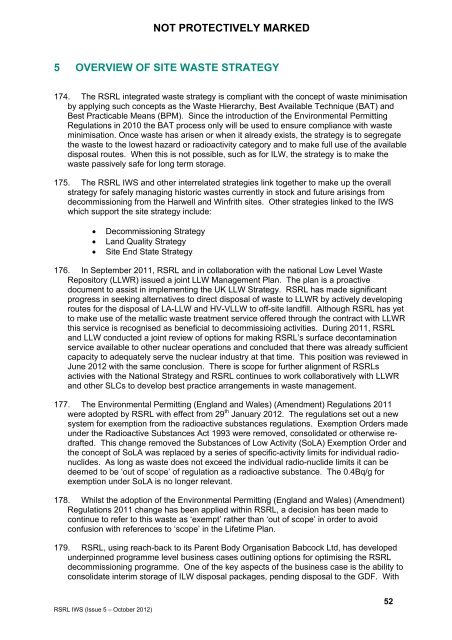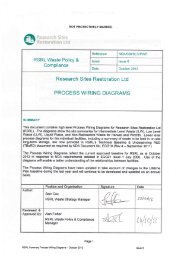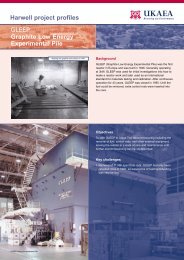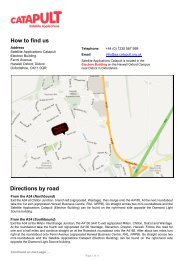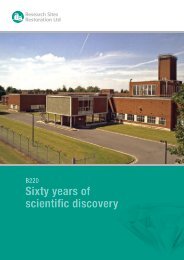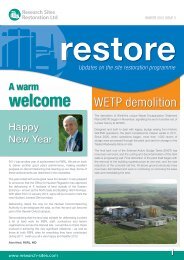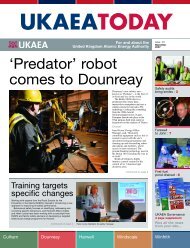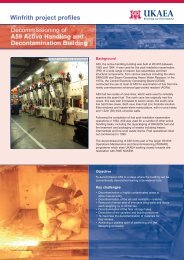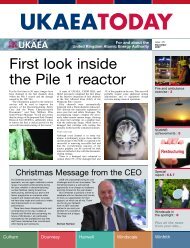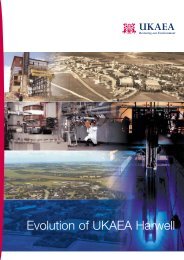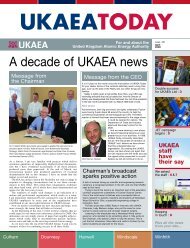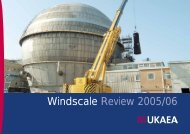RSRL Integrated Waste Strategy - Issue 5- Oct 2012.pdf
RSRL Integrated Waste Strategy - Issue 5- Oct 2012.pdf
RSRL Integrated Waste Strategy - Issue 5- Oct 2012.pdf
You also want an ePaper? Increase the reach of your titles
YUMPU automatically turns print PDFs into web optimized ePapers that Google loves.
NOT PROTECTIVELY MARKED5 OVERVIEW OF SITE WASTE STRATEGY174. The <strong>RSRL</strong> integrated waste strategy is compliant with the concept of waste minimisationby applying such concepts as the <strong>Waste</strong> Hierarchy, Best Available Technique (BAT) andBest Practicable Means (BPM). Since the introduction of the Environmental PermittingRegulations in 2010 the BAT process only will be used to ensure compliance with wasteminimisation. Once waste has arisen or when it already exists, the strategy is to segregatethe waste to the lowest hazard or radioactivity category and to make full use of the availabledisposal routes. When this is not possible, such as for ILW, the strategy is to make thewaste passively safe for long term storage.175. The <strong>RSRL</strong> IWS and other interrelated strategies link together to make up the overallstrategy for safely managing historic wastes currently in stock and future arisings fromdecommissioning from the Harwell and Winfrith sites. Other strategies linked to the IWSwhich support the site strategy include:• Decommissioning <strong>Strategy</strong>• Land Quality <strong>Strategy</strong>• Site End State <strong>Strategy</strong>176. In September 2011, <strong>RSRL</strong> and in collaboration with the national Low Level <strong>Waste</strong>Repository (LLWR) issued a joint LLW Management Plan. The plan is a proactivedocument to assist in implementing the UK LLW <strong>Strategy</strong>. <strong>RSRL</strong> has made significantprogress in seeking alternatives to direct disposal of waste to LLWR by actively developingroutes for the disposal of LA-LLW and HV-VLLW to off-site landfill. Although <strong>RSRL</strong> has yetto make use of the metallic waste treatment service offered through the contract with LLWRthis service is recognised as beneficial to decommissioing activities. During 2011, <strong>RSRL</strong>and LLW conducted a joint review of options for making <strong>RSRL</strong>’s surface decontaminationservice available to other nuclear operations and concluded that there was already sufficientcapacity to adequately serve the nuclear industry at that time. This position was reviewed inJune 2012 with the same conclusion. There is scope for further alignment of <strong>RSRL</strong>sactivies with the National <strong>Strategy</strong> and <strong>RSRL</strong> continues to work collaboratively with LLWRand other SLCs to develop best practice arrangements in waste management.177. The Environmental Permitting (England and Wales) (Amendment) Regulations 2011were adopted by <strong>RSRL</strong> with effect from 29 th January 2012. The regulations set out a newsystem for exemption from the radioactive substances regulations. Exemption Orders madeunder the Radioactive Substances Act 1993 were removed, consolidated or otherwise redrafted.This change removed the Substances of Low Activity (SoLA) Exemption Order andthe concept of SoLA was replaced by a series of specific-activity limits for individual radionuclides.As long as waste does not exceed the individual radio-nuclide limits it can bedeemed to be ‘out of scope’ of regulation as a radioactive substance. The 0.4Bq/g forexemption under SoLA is no longer relevant.178. Whilst the adoption of the Environmental Permitting (England and Wales) (Amendment)Regulations 2011 change has been applied within <strong>RSRL</strong>, a decision has been made tocontinue to refer to this waste as ‘exempt’ rather than ‘out of scope’ in order to avoidconfusion with references to ‘scope’ in the Lifetime Plan.179. <strong>RSRL</strong>, using reach-back to its Parent Body Organisation Babcock Ltd, has developedunderpinned programme level business cases outlining options for optimising the <strong>RSRL</strong>decommissioning programme. One of the key aspects of the business case is the ability toconsolidate interim storage of ILW disposal packages, pending disposal to the GDF. With<strong>RSRL</strong> IWS (<strong>Issue</strong> 5 – <strong>Oct</strong>ober 2012)52


